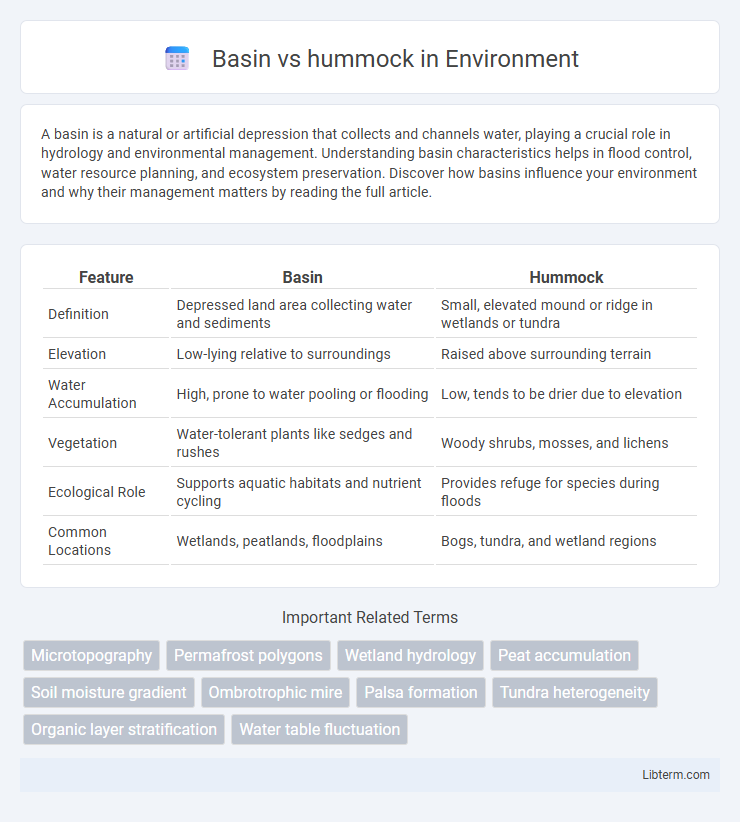A basin is a natural or artificial depression that collects and channels water, playing a crucial role in hydrology and environmental management. Understanding basin characteristics helps in flood control, water resource planning, and ecosystem preservation. Discover how basins influence your environment and why their management matters by reading the full article.
Table of Comparison
| Feature | Basin | Hummock |
|---|---|---|
| Definition | Depressed land area collecting water and sediments | Small, elevated mound or ridge in wetlands or tundra |
| Elevation | Low-lying relative to surroundings | Raised above surrounding terrain |
| Water Accumulation | High, prone to water pooling or flooding | Low, tends to be drier due to elevation |
| Vegetation | Water-tolerant plants like sedges and rushes | Woody shrubs, mosses, and lichens |
| Ecological Role | Supports aquatic habitats and nutrient cycling | Provides refuge for species during floods |
| Common Locations | Wetlands, peatlands, floodplains | Bogs, tundra, and wetland regions |
Introduction to Basin and Hummock
A basin is a low-lying geographic depression that collects water, often forming lakes, wetlands, or ponds, playing a crucial role in hydrology and sediment deposition. Hummocks are small, rounded mounds or knolls typically formed by soil accumulation or frost heave, influencing microtopography and vegetation patterns in various ecosystems. Understanding basins and hummocks is essential for studying landscape morphology, water flow, and habitat diversity.
Defining Basins: Key Characteristics
Basins are depression-like landforms characterized by a closed drainage system where water accumulates without an outlet, often forming lakes or wetlands. They typically feature lower elevation relative to surrounding terrain, allowing sediment and organic materials to settle, influencing soil composition and local ecosystems. Basins contrast with hummocks, which are raised, isolated mounds or knolls found in glacial and permafrost regions, impacting hydrology and biodiversity differently.
Hummocks Explained: Features and Types
Hummocks are elevated landforms characterized by their small, rounded mounds or knolls, often formed by natural processes such as frost heaving, volcanic activity, or peat accumulation, contrasting basins which are depressions or low-lying areas typically collecting water or sediment. Features of hummocks include their relatively uniform shapes, distinct vegetation zones due to micro-topographic variations, and resistance to erosion, making them prominent in tundra, bog, and volcanic landscapes. Types of hummocks vary widely, including permafrost-induced frost hummocks, bog hummocks formed by peat buildup, and lava hummocks shaped by volcanic flows, each with unique formation mechanisms and ecological significance.
Formation Processes: Basin vs Hummock
Basins typically form through subsidence, erosion, or glacial melting, creating large, often water-filled depressions in the landscape. Hummocks arise from soil and organic material accumulation, frost heaving, or volcanic activity, resulting in small, raised mounds with irregular shapes. The distinct formation processes determine their contrasting topography and ecological functions in various environments.
Ecological Functions and Roles
Basins serve as critical wetlands that regulate hydrology by storing floodwaters and supporting diverse aquatic habitats, enhancing nutrient cycling and sediment deposition. Hummocks provide elevated microhabitats within wetland ecosystems, promoting plant biodiversity by offering refuge from flooding and fostering soil stabilization through root systems. Both landforms contribute to ecosystem resilience, with basins supporting water filtration and carbon sequestration, while hummocks facilitate species diversity and habitat complexity.
Hydrological Differences
Basins typically serve as larger depression areas that collect and store substantial water, creating ponds, lakes, or wetlands, which influence surface water accumulation and groundwater recharge patterns. Hummocks are smaller, elevated mounds that promote faster water runoff, reduce water retention, and often create microhabitats with different moisture levels compared to surrounding areas. Hydrologically, basins enhance water pooling and infiltration, whereas hummocks facilitate drainage and limit prolonged water saturation.
Soil and Vegetation Variations
Basin soils typically exhibit higher moisture content and nutrient accumulation, supporting hydrophilic vegetation such as sedges and cattails. Hummocks feature well-drained, aerated soils with lower moisture retention, fostering drought-tolerant plants like shrubs and lichens. These soil moisture gradients create distinct microhabitats, influencing plant species diversity and distribution within wetland ecosystems.
Importance in Wetland Ecosystems
Basins and hummocks play crucial roles in wetland ecosystems by creating microhabitats that support diverse plant and animal species. Basins, typically lower-lying areas, accumulate water and organic matter, fostering anaerobic conditions essential for nutrient cycling and carbon sequestration. Hummocks, elevated mounds of soil and vegetation, enhance habitat heterogeneity by providing refuge for species sensitive to prolonged flooding and contribute to the structural complexity vital for wetland resilience.
Human Impact and Land Use
Human activities significantly alter basins and hummocks, with basins often modified for agriculture or urban development due to their water collection and fertile soil properties. Hummocks, characterized by elevated, uneven terrain, face land use changes mainly through deforestation and mining, disrupting natural habitats and soil stability. Both landforms experience ecological pressure from construction and land conversion, affecting biodiversity and hydrological cycles.
Conclusion: Comparing Basins and Hummocks
Basins and hummocks represent distinct landforms with opposite hydrological roles; basins collect and retain water, creating wetlands or ponds, while hummocks are elevated mounds that shed water and support different vegetation. Understanding their contrasting drainage patterns and soil moisture conditions is crucial for wetland ecology and land management. Effective habitat restoration and watershed planning depend on accurately identifying and utilizing the unique environmental functions of basins versus hummocks.
Basin Infographic

 libterm.com
libterm.com